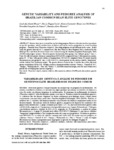Use este identificador para citar ou linkar para este item:
http://www.alice.cnptia.embrapa.br/alice/handle/doc/210999Registro completo de metadados
| Campo DC | Valor | Idioma |
|---|---|---|
| dc.contributor.author | ALZATE-MARIN, A. L. | pt_BR |
| dc.contributor.author | COSTA, M. R. | pt_BR |
| dc.contributor.author | SARTORATO, A. | pt_BR |
| dc.contributor.author | DEL PELOSO, M. J. | pt_BR |
| dc.contributor.author | BARROS, E. G. de | pt_BR |
| dc.contributor.author | MOREIRA, M. A. | pt_BR |
| dc.date.accessioned | 2012-12-19T23:00:29Z | - |
| dc.date.available | 2012-12-19T23:00:29Z | - |
| dc.date.created | 2003-05-22 | pt_BR |
| dc.date.issued | 2003 | pt_BR |
| dc.identifier.citation | Scientia Agricola, v. 60, n. 2, p. 283-290, abr./jun. 2003. | pt_BR |
| dc.identifier.uri | http://www.alice.cnptia.embrapa.br/alice/handle/doc/210999 | pt_BR |
| dc.description | Genetic diversity is essential for any breeding program. However, breeders tend to concentrate on specific genotypes, which combine traits of interest and may be used as progenitors in several breeding programs. Common bean (Phaseolus vulgaris L.) breeding programs are not different in this sense. In this study, the genetic diversity of 21 common bean elite lines from the Bean Regional Trials conducted by the Embrapa Rice and Bean Research Center was evaluated using the Random Amplified Polymorphic DNA (RAPD) and pedigree analyses. Based on genetic dissimilarity, three groups were defined: group I - lines 1, 9 and 10, with low genetic distances among them (0.00 to 0.06), originated from 11 Mesoamerican parents; group II - 17 lines with genetic distances ranging from 0.03 to 0.33, originated from 50 parents (mostly Mesoamerican); and group III - line 21 (PR 93201472), which parents are the Andean cultivar 'Pompadour' and the cultivar 'Irai' (unknown origin). The genetic distances between line 21 and the lines of the other two groups varied from 0.68 to 0.93. Pedigree analyses demonstrated that cultivars 'Carioca', 'Cornell 49-242', 'Jamapa', 'Tlalnepantla 64', 'Tara' and 'Veranic 2', all of Mesoamerican origin, were the most widely used parents for developing lines present in group II. | pt_BR |
| dc.language.iso | eng | eng |
| dc.rights | openAccess | eng |
| dc.subject | Cultivares andinos | pt_BR |
| dc.subject | Cultivares Mesoamericanos | pt_BR |
| dc.subject | RAPD | pt_BR |
| dc.subject | Distancia | pt_BR |
| dc.title | Genetic variability and pedigree analysis of brazilian common bean elite genotypes. | pt_BR |
| dc.type | Artigo de periódico | pt_BR |
| dc.date.updated | 2012-12-19T23:00:29Z | pt_BR |
| dc.subject.thesagro | Feijão | pt_BR |
| dc.subject.thesagro | Genética | pt_BR |
| dc.subject.thesagro | Marcador Molecular | pt_BR |
| dc.subject.thesagro | Melhoramento | pt_BR |
| dc.subject.thesagro | Phaseolus Vulgaris | pt_BR |
| riaa.ainfo.id | 210999 | pt_BR |
| riaa.ainfo.lastupdate | 2012-12-19 | pt_BR |
| dc.identifier.doi | https://doi.org/10.1590/S0103-90162003000200012 | eng |
| dc.contributor.institution | ANA LILIA ALZATE-MARIN, UFV; MARCIA REGINA COSTA, UFV; ALOISIO SARTORATO, CNPAF; MARIA JOSE DEL PELOSO, CNPAF; EVERALDO GONÇALVES DE BARROS, UFV; MAURILIO ALVES MOREIRA, UFV. | pt_BR |
| Aparece nas coleções: | Artigo em periódico indexado (CNPAF)  | |
Arquivos associados a este item:
| Arquivo | Descrição | Tamanho | Formato | |
|---|---|---|---|---|
| 15330.pdf | 193,65 kB | Adobe PDF |  Visualizar/Abrir |









